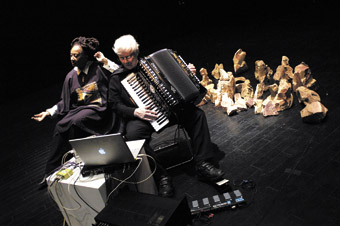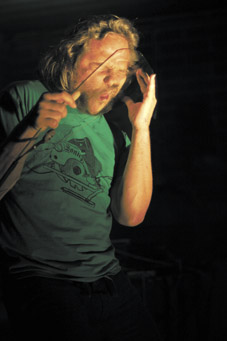sound in mind and body
chris reid happily imbibes liquid architecture 8, melbourne

Pauline Oliveros and Ione
photo Heroku Ikeda, courtesy of Kanazawa Museum of Art
Pauline Oliveros and Ione
THE ANNUAL SOUND ART EXTRAVAGANZA, LIQUID ARCHITECTURE, IS AN INTERNATIONALLY SIGNIFICANT EVENT THAT PROVIDES AUDIENCES WITH A CROSS-SECTION OF THE NEWEST AND BEST IN THE FIELD. WITH PERFORMERS FROM ACROSS AUSTRALIA, THE US, FRANCE AND SWITZERLAND, WORKING IN DIVERSE FIELDS, THIS WAS A FABULOUS SEASON. SOUND ART CAN EMBRACE EXPERIMENTAL MUSIC, NEW MEDIA AND PERFORMANCE ART; THIS YEAR’S LA FESTIVAL FEATURED ALL OF THESE AND ALSO LOOKED BACK AT THE ROOTS OF AUSTRALIAN SOUND ART AND ITS GREATEST EXPONENTS.
The program opened with performances by three younger composers. Dean Linguey performed on an apparatus comprising two sheets of steel suspended from a frame and connected by metal wires. Electric transducers vibrate the closely microphoned sheets and the vibrations are broadcast through a mixer and the PA. Linguey orchestrates a complex polyphonic signal into engaging music by touching or pressing the metal with his hands. Camilla Hannan’s work involves reprocessed field recordings orchestrated into a delightful composition that hovers between music and audio-documentary, taking you into worlds of memory and imagination. Nigel Wright creates engaging experimental musical compositions using a laptop. These composer-performers showcased three of the primary ways of generating sound—using a vibrating object (most musical instruments fall into this category), morphing and blending recordings of ambient, environmental or sampled sounds, and orchestrating synthesised sound. Much sound art traditionally falls somewhere along this continuum. The listener responds to the sound as music but is also teased by the recognisability of particular sounds, and notices how they are transformed and mixed, the melodic or harmonic lines and patterns that develop, spatial effects and the incorporation into the mix of performative by-products such as resonances, overtones and feedback. Every artist establishes a unique language.
australian sound art history
The same night saw the launch of the CD of Australian sound art pioneers, Artefacts of Australian Experimental Music: 1930-1973, compiled by Clinton Green, and a panel discussion between notable composer/performers Pauline Oliveros, Rainer Linz, Robin Fox and Warren Burt (a former Oliveros student). Before a large and interested audience, this evening was a significant moment in the history of Australian sound art, and discussion ranged over the nature and legacy of Australia’s early experimental music and the lack of acknowledgement of the important work that has emerged. In Australia, the field developed particularly in the 1970s through the work of Burt, Keith Humble and Ron Nagorcka and through the establishment of university courses in the area, and has since gained impetus through international travel and recording distribution. But the roots go back to the 1930s and Percy Grainger is counted as a pioneer. The panel concluded that the Australian sound art scene is now firmly part of a global community. Echoing a cry throughout the arts, they lamented the continuing lack of news-media attention and of funding for experimental music and sound art.
Following the panel discussion, Fox performed on early synthesisers retrieved from a dumpster at the closure of an important 1970s Melbourne studio, and blended into the mix some elements from recordings made at the time.
deep listening
Pauline Oliveros, a leader in sound art in the US since the 1950s, is the founder of Deep Listening®, a mediation practice that involves shifting focus from a particular sound to all ambient sound and listening exclusively or inclusively. Her delightful performances with her collaborator Ione were highly refined musical compositions. While in Australia, Oliveros had also performed a remix of one of her 1960s works (see RT80, p51), so the lineage of experimental music and sound art was laid before us.
In the Melbourne leg of LA8, Oliveros and Ione’s Saturday afternoon Deep Listening workshop was not to be missed. After a series of warm-up exercises, our attention was focussed on the nature of listening and the awareness and recognition of ambient sound. We heard unmediated the ambient sounds such as birds, cars and trams that sound artists so often mimic, reuse or parody. Deep Listening is also about experiencing one’s own body, how it hears, feels and itself produces sound, and how hearing and feeling connect. The workshop reminded us of how we categorise sound as musical, unmusical or noise, depending on context, memory, experience and taste.
into the labyrinth
On the concluding night, the audience was marshalled through the rear door of the auditorium into an underground carpark/loading bay—which became a quintessentially urban arena—and given earplugs. Earplugs at a concert? The evening opened with Perth-based quartet Abe Sada (recalling the name of the 1930s Japanese geisha who notoriously suffocated and then castrated her lover), who perform on electric bass guitars connected through effects pedals to massive amplifiers. For this set, they were joined by Robin Fox on laptop, and the performers spread themselves around the space, coordinating their improvisations through aural rather than visual cues, with brief flourishes and squealing feedback overlaying long, rumbling drones. Slow, subtle and introspective, this is darkly beautiful music that partly builds on the aesthetic that emerged in the Hendrix era of the electric guitar, but which draws more on the ethos of sound art to establish a unique and compelling oeuvre.

Justice Yeldam, Liquid Architecture 8
photo Christina Tester
Justice Yeldam, Liquid Architecture 8
Following Abe Sada was the astonishing Justice Yeldham and the Dynamic Ribbon Device. As well as the Coca-Cola insignia, the term Dynamic Ribbon Device might refer to the contact microphone attached to the large chunk of window pane that Yeldham (Lucas Abela) holds in his hands and against which he presses his face as he bawls his rant, or to the blood flowing from his hands and mouth as the performance progresses and the glass slowly disintegrates. The mike is connected via effects pedals to a large amplifier, so that Yeldham’s cathartic yelling is transmuted into nearly abstract sound, though never abstract enough to blunt the emotional power of his soliloquy. More performance art than sound art, it recalls the tradition of performance and body art from Chris Burden, Mike Parr and Stelarc to Monika Tichacek, amongst numerous others, in which artists violate their own bodies, drawing attention to the nature and vulnerability of human flesh, its colonisation and the possibility of redemption through suffering. Abela’s is art at its most primal.
Runzelstirn and Gurgelstock (in fact one artist, Rudolf Eb.er of Switzerland) followed, with the performer, wearing a pig mask with a mike in it, sitting in a car and declaiming unintelligibly through a mixer and PA. Again, more performance than sound art, it was mockingly ironic, as if revealing the tormented psyche of a commuter caught in a traffic jam, and resonating with the carpark metaphorically as well as literally. Overall, the evening was more urban theatre than concert.
This LA season focussed very much on the listener and the nature of listening. The contrast for the audience between Justice Yeldham’s visceral performance, Abe Sada’s tectonic reverberations and Pauline Oliveros and Ione’s meditative music was profound. Important in sound art is the experience of the body—both the performer’s and the listener’s—its haptic awareness and its location in site and space. Sound art is about the technical means of making and orchestrating musical sounds and it can carry incisive political and social commentary. It is very much about the physical, intellectual and musical experience of listening and the triggering of memory and emotion. The best works touch us at every level. Director Nat Bates’ thoughtful programming has made for a memorable LA festival that has once again revealed the breadth, depth and potential of sound art.
Liquid Architecture 8, director Nat Bates, Arts House, North Melbourne Town Hall, July 11-13, RMIT University, Melbourne, July 14
RealTime issue #81 Oct-Nov 2007 pg. 45






